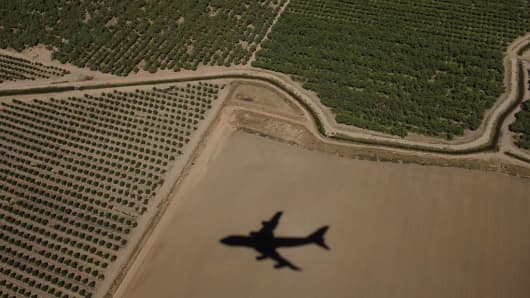
"This year we still have a drought but it's not nearly as bad as 2014 or 2015 for agriculture," said Jay Lund, director of the UC Davis Center for Watershed Sciences and one of the authors of the analysis. "But the state isn't out of the woods as a lack of rain in 2017 could put California back in bad shape."
About 78,800 acres of farmland are projected to be idled this year due to the ongoing drought. That is a small number compared with the estimated 540,000 acres of fallowed land in 2015. Overall, the state's agriculture industry represents around 9.3 million acres of irrigated crops.
"Almost all fallowed land due to drought is projected to be on the west side of the San Joaquin Basin, which relies heavily on water imports," according to the UC Davis analysis. "No significant drought-related impacts are expected for livestock and dairies this year as this sector is more affected by market conditions than drought this year."
The study predicts water shortages in 2016 will cost the ag industry a total of $550 million in direct costs and 1,815 in lost jobs. That compares with an estimated $1.8 billion in direct costs and 10,100 in jobs last year, the UC Davis researchers said.
When looking at the drought's total impact, including from businesses supporting farming and the loss of household incomes, the ag region losses this year are forecast to top $600 million and 4,700 jobs statewide. Researchers put the total economic loss last year at roughly $2.7 billion and 21,000 jobs statewide.
"Water costs are coming down from the highs farmers paid a year ago," said Lund.
Some farmers have seen water costs go up sharply, making growing certain crops unprofitable. During the drought, it hasn't been unusual for farmers to see water costs of $1,000 per acre-foot and above — well above the cost of roughly $120 per acre-foot they were accustomed to before the drought. Higher-priced water has tended to go to permanent crops such as tree nuts, orchard fruits and wine grapes.
Researchers said surface water supply for crops was roughly 14 percent less than normal statewide. Groundwater was responsible for offsetting roughly 70 percent of the ag industry's surface water deficit statewide, researchers said.
The analysts pointed out that there were substantial rains in the northern part of the state that required several reservoirs to spill water for flood control purposes. Areas south of California's Sacramento-San Joaquin River Delta, where two of the state's major riverways converge, have seen drier conditions.
The U.S. Drought Monitor released last Thursday showed 59 percent of California remains in severe drought conditions, down from about 88 percent at the start of the calendar year. About 21 percent of the state remains in exceptional drought, although that compares with nearly 45 percent at the start of the year.
Monday, 15 Aug 2016 | 4:21 PM ETCNBC.com
source: http://www.cnbc.com/
original story HERE
Get more of The Global Warming Blog. Bookmark this page and sign up for the blog’s free RSS Feed. Sign up for free Global Warming Blog by clicking here. You will automatically be emailed a regular summary of the latest global warming headlines.
To help do something about the climate change and global warming emergency, click here.
Sign up for our free Global Warming Blog by clicking here. (In your email, you will receive critical news, research, and the warning signs for the next global warming disaster.)
To share this blog post: Go to the Share button to the left below.


Be the first to comment
Sign in with